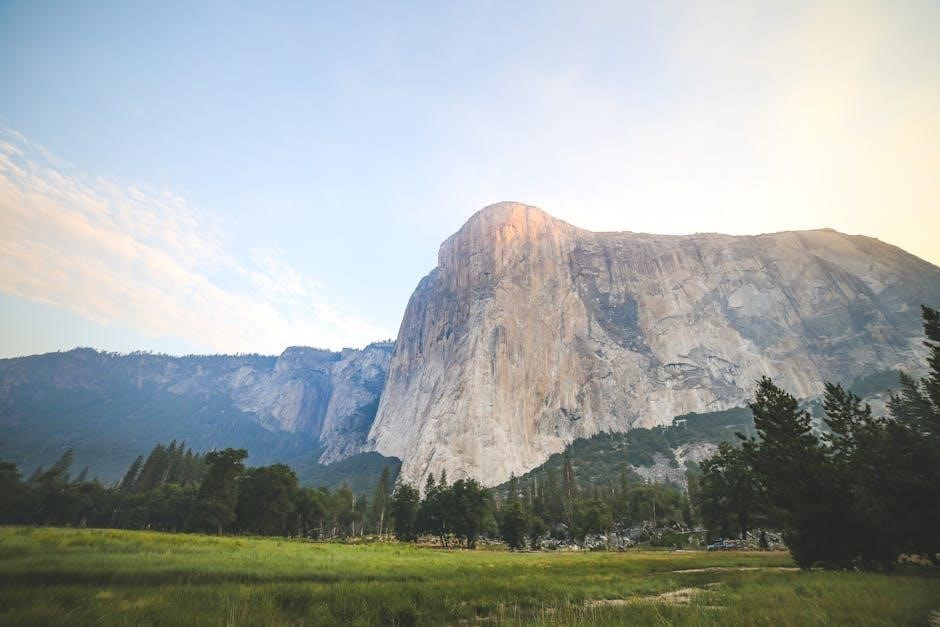Overview of National Geographic’s Guide to National Parks
National Geographic’s guide, now in its 9th edition, profiles all 63 U․S․ National Parks․ It’s a comprehensive resource for nature and outdoor enthusiasts․ The guide includes expert travel advice, hiking tips, and detailed maps․ It covers everything from Alaska to the Virgin Islands․
Purpose and Scope of the Guide
The primary purpose of National Geographic’s Guide to National Parks is to provide comprehensive and informative resources for travelers planning visits to America’s national parks․ This enduring guide aims to inspire exploration and appreciation of these protected natural and cultural landscapes, offering expert advice to ensure safe and enriching experiences․
The scope of the guide encompasses all 63 United States National Parks, from the vast wilderness of Alaska to the tropical beauty of the Virgin Islands․ It meticulously details each park’s unique features, including geological formations, diverse ecosystems, historical significance, and recreational opportunities․ The guide serves as an invaluable tool for both first-time visitors and seasoned park enthusiasts, offering a wealth of knowledge to enhance their understanding and enjoyment of these national treasures․
Furthermore, the guide extends beyond mere descriptions, providing practical information on park accessibility, lodging options, camping facilities, and potential hazards․ By offering candid tips and expert insights, it empowers readers to plan their trips effectively, making the most of their time in these remarkable destinations․ Ultimately, the guide aims to foster a deeper connection between people and the natural world, promoting responsible stewardship and conservation of these irreplaceable resources for future generations․

Key Features of the Guide
National Geographic’s guide offers expert travel advice, detailed maps, and park information․ It also provides hiking and outdoor activity suggestions․ Beautifully written descriptions tell the stories of the parks, helping readers plan their visit effectively and safely․
Expert Travel Advice and Tips
National Geographic’s guide provides invaluable expert travel advice, ensuring visitors can make the most of their national park experiences․ This section offers candid tips for hiking and exploring, detailing the best times to visit, what to pack, and how to navigate each park’s unique terrain․
The guide emphasizes safety, providing information on potential hazards and how to avoid them․ It includes advice on wildlife encounters, weather conditions, and trail safety․ Practical tips, such as permit requirements, reservation procedures, and transportation options within the parks, are also covered extensively․
Furthermore, the guide offers insights into less-crowded times to visit popular parks, allowing for a more serene and immersive experience․ It also suggests alternative activities for when certain areas are congested․ Expert advice also highlights the unique cultural and historical aspects of each park, enriching the visitor’s understanding and appreciation․ The information is designed to help both seasoned travelers and first-time visitors plan unforgettable adventures․
Finally, the guide includes advice on sustainable travel practices, encouraging visitors to minimize their impact on the environment and support local communities․ Through these tips, National Geographic’s guide helps travelers explore responsibly․
Detailed Maps and Park Information
National Geographic’s guide excels in providing detailed maps and comprehensive park information, crucial for effective trip planning and on-site navigation․ Each park profile includes high-quality, easy-to-read maps highlighting trails, landmarks, visitor centers, and points of interest․ These maps are invaluable for hikers, campers, and anyone exploring the park’s vast landscapes․
Beyond maps, the guide offers extensive information on each park’s natural and cultural history․ It details the geological formations, flora, and fauna, as well as the historical significance of the area․ The guide also provides practical information such as operating hours, entrance fees, and contact details for park services․ This includes ranger stations, medical facilities, and emergency contacts․
Detailed park information includes descriptions of various activities available, from hiking and camping to wildlife viewing and ranger-led programs․ Accessibility information is also provided, catering to visitors with disabilities․ Furthermore, the guide offers insights into the park’s unique challenges, such as climate change impacts and conservation efforts, fostering a deeper understanding and appreciation for these protected areas․ The combination of detailed maps and comprehensive information makes this guide an indispensable resource for exploring America’s national parks․
Hiking and Outdoor Activity Suggestions
National Geographic’s guide is packed with suggestions for hiking and outdoor activities, catering to all skill levels and interests․ Whether you’re a seasoned backpacker or a family looking for a leisurely stroll, the guide offers a plethora of options to explore each park’s unique landscape․ It details trails with varying lengths and difficulty ratings, providing essential information on elevation gain, trail conditions, and potential hazards․
For each suggested activity, the guide offers insights into the best time of year to visit, necessary gear, and permits required․ It also highlights points of interest along the trail, such as scenic viewpoints, waterfalls, and historical landmarks․ Beyond hiking, the guide covers a wide range of outdoor activities, including camping, fishing, kayaking, and wildlife viewing․ It provides tips on responsible outdoor recreation, emphasizing Leave No Trace principles to minimize environmental impact․
The guide includes information on ranger-led programs and guided tours, offering opportunities to learn more about the park’s natural and cultural history․ It also highlights less crowded areas and off-the-beaten-path destinations, providing options for those seeking solitude and a more immersive experience․ With its comprehensive coverage of hiking and outdoor activities, National Geographic’s guide empowers readers to plan unforgettable adventures in America’s national parks․

New Additions and Updates in Recent Editions
Recent editions include new parks like Indiana Dunes and White Sands․ These updated editions feature 750+ off-the-beaten-path destinations․ The guide now covers 63 national parks․ This provides readers with even more expert travel advice and tips․
Inclusion of New National Parks
The latest editions of National Geographic’s guide to National Parks showcase the newest additions to the United States park system, ensuring that readers have access to the most up-to-date information available․ This includes detailed profiles of recently designated National Parks such as Indiana Dunes National Park, known for its stunning shoreline along Lake Michigan, and White Sands National Park, famous for its surreal landscape of glistening white gypsum dunes․ Gateway Arch National Park is also included․
The inclusion of these new parks expands the scope of the guide, offering readers a wider range of destinations to explore and discover․ Each new park profile features the same level of comprehensive coverage as the established parks, including expert travel advice, detailed maps, and suggestions for hiking and outdoor activities․
By incorporating these new additions, National Geographic ensures that its guide remains a relevant and indispensable resource for anyone planning a trip to the National Parks․ The updates reflect the ongoing expansion and evolution of the National Park System․
This commitment to providing the latest information allows readers to fully appreciate the diverse natural and cultural treasures preserved within the boundaries of these newly designated parks․
Off-the-Beaten-Path Destinations
Beyond the iconic landmarks and well-trodden trails, National Geographic’s guide also shines a light on off-the-beaten-path destinations within and around the National Parks․ This expanded coverage caters to travelers seeking unique and less crowded experiences, offering a glimpse into the hidden gems and lesser-known corners of these protected areas․ The fifth edition includes 750 additional off-the-beaten-path destinations․
These destinations might include secluded hiking trails leading to breathtaking vistas, remote campgrounds offering unparalleled solitude, or historical sites that reveal fascinating stories of the past․ The guide provides detailed descriptions of these hidden treasures, along with practical information on how to access them and what to expect upon arrival․
By venturing beyond the popular tourist spots, travelers can discover a deeper connection with nature and a more authentic understanding of the parks’ diverse ecosystems and cultural heritage․ National Geographic’s guide encourages exploration and discovery․
These hidden destinations provide the opportunity to escape the crowds and experience the tranquility and serenity of the wilderness․ They offer a chance to create unforgettable memories away from the hustle and bustle of the main tourist areas, fostering a sense of adventure and exploration․ Stories of the parks are beautifully written․

The App version
The National Geographic National Parks app complements the guide․ It offers the main park guide features․ Its tremendous UI provides easy access to information․ The app enhances the exploration experience․ It brings park details to your fingertips․
tremendous UI
The National Geographic National Parks app boasts a tremendous User Interface (UI), designed to enhance user experience․ Its intuitive layout ensures easy navigation, allowing users to quickly access essential park information․ The UI integrates detailed maps, expert travel advice, and hiking tips seamlessly․ Users can effortlessly explore park profiles, view stunning photographs, and discover off-the-beaten-path destinations with just a few taps․
The app’s design prioritizes accessibility, making it user-friendly for all ages and tech-savviness levels․ Interactive elements and clear visuals guide users through the app’s features․ The UI also incorporates offline functionality, enabling access to downloaded content even without an internet connection․ This feature is particularly useful for exploring remote areas within the national parks․
Furthermore, the app’s UI is regularly updated to incorporate user feedback and incorporate new features․ The developers consistently strive to improve the app’s performance and ensure a seamless and enjoyable user experience․ The tremendous UI is a key factor in the app’s popularity among national park enthusiasts․ It transforms park information into an engaging and interactive experience․

